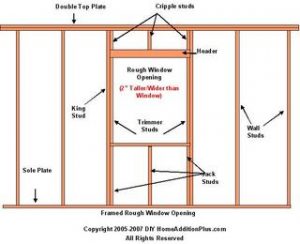A how to guide for Framing a Window Opening
By Mark J. Donovan
|
|
Installing a new window in your home typically requires the need for demolition and framing. Described below is the process for framing a window opening.
Site Preparation for Framing a Window Prior to any demolition make sure you have confirmed that all electricity and plumbing have been turned off that may be associated with the area you plan on installing the new window. |
Also make sure you have cleared the area of furniture and have laid a tarp down on the floor.
If the wall is a weight-bearing wall, make sure you brace up the ceiling first before removing any of the existing studs. You can usually do this with a few 2x4s fashioned into a T configuration. Trace out the approximate window frame location on the wall using a pencil or marker.
| Site Demolition for Framing Rough Window Opening
Next, using a carpenters knife score the sheetrock. Make sure you penetrate all the way through the sheetrock. Note that you will have to remove a section of sheet rock that goes floor to ceiling. Now remove the sheetrock with a hammer and claw. It is best to immediately dispose of the sheetrock to keep the jobsite clean. |
 |
Remove Required Studs and Sole Plate Section to Framing a Window
Next, mark on the top plate and bottom sole plate the rough opening locations for the window. Note, that the rough window opening should be about 2 inches wider and taller than the window itself. Also allow for an additional 3 inches to account for the width of 2 studs on each side of the window (King Stud and Jack/Trimmer Studs).
Now remove the stud(s) that lie within the marked rough window opening.
| Framing Rough Window Opening
Next install the King studs. A King stud should sit on each side of the rough window opening and should connect the top plate and sole plate together. Toe nail them into position, and use a level to make sure they are plumb. Warning: Make sure that when you install the King studs you have also accounted for the width of the Jack/Trimmer studs. It is the spacing between the trimmer studs that should be approximately 2 inches wider than the actual window. Next install Jack studs up against the two King studs. The Jack studs should be placed to the inside of the window opening and should have a height that is equal to the height of the base of the window opening. |

Get this “Installing a New Window” eBook today to learn how to install a new window quick and error-free. It is loaded with detailed instructions and helpful window installation pictures. |
The Jack studs should be both toe nailed and nailed to the king jacks.
Now install a sill plate that will rest on top of the Jack studs. The new window will eventually sit on this sill plate. The sill plate is constructed using either a 2”x4” or 2”x6”, pending the exterior wall construction, and laid on its flat side on top of the Jack studs. Nail the sill plate to the Jack studs and King studs.
|
Next, install additional center Jack studs (as required) underneath the sill plate. The center Jack studs should be located on 16 inch centers between the edge Jack studs. With the sill plate installed, it is now time to install trimmer studs that rest on top of the sill plate and sit flush up against the King studs. The trimmer studs should be of a length that is approximately 2 inches higher than then the actual height of the window. The trimmer studs should be nailed flush to the King studs. |
|
Now install a Header that will rest on top of the Trimmer studs. The header should consist of two 2x6s, 2×8’s, etc. (pending local code requirements) sections married/nailed together and laid on their edge on top of the trimmer studs. Note that spacers may be required between the Header boards, pending the width of the framing used on the exterior wall (e.g. if the walls were framed with 2”x6”s then spacers will be required between the two header boards). The Header should be nailed into the King studs.
Finally add cripple studs over the header. Cripple studs should be installed on both the left and right side of the header and be nailed into the King studs. They should also be toe nailed into the top plate and header.
Additional Cripple studs should also be installed (on 16” centers) between the edge Cripple studs.
The center Cripple studs should be toe nailed into the Header and the top plate.
If framed correctly the rough window opening should be complete and about 2 inches taller and wider than the window itself.
You have now completed the framing of rough window frame and are ready for installing the window.
For more help on building a home addition, see HomeAdditionPlus.com’s Home Addition Bid Sheets. Our Home Addition Bid Sheets provide you with the knowledge and information on how to plan a home building project, and what to look for when hiring contractors. They also include detailed cost breakdown tables and spreadsheets for estimating your own new home construction building costs.
Related Information
- Floor Joist Bracing
- How to Install Interior Window Trim
- Cripple Wall Framing
- How to Install an Octagon Window
Additional Framing Resources from Amazon.com
 |
 |
Free Home Addition Price Quotes with No Obligation!
Fill out our 3-5 minute quick and easy form, and receive a free price quote on a house addition from one of our prescreened and licensed home addition contractors. This process is free and there is no obligation to continue once you receive your home addition price estimate.

